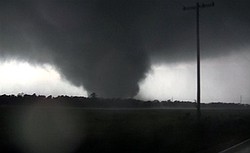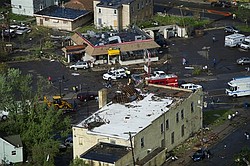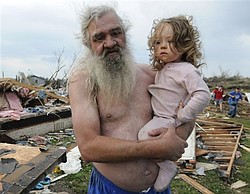NWS says 2011 is deadliest year for tornadoes since 1950
ASSOCIATED PRESS
This frame grab from video shows a massive tornado on Sunday, May 22, 2011, outside Joplin, Mo. The tornado tore a 6-mile path across southwestern Missouri killing at least 89 people as it slammed into the city of Joplin, ripping into a hospital, crushing cars like soda cans and leaving a forest of splintered tree trunks behind where entire neighborhoods once stood.
AP
This aerial view shows tornado damage in Minneapolis, Sunday, May 22, 2011. At least one person died when the tornado barreled through the residential portion of Minneapolis on Sunday, damaging at least 100 homes, toppling hundreds of trees and injuring at least 29 people.
AP
Willie Hyde holds his grand daughter 2-years-old Sierra Goldsmith near where their house stood in Concord Ala., after what appeared to be a tornado ripped through parts of the town late Wednesday, April 27, 2011. The damage in the area is extensive with homes and businesses destroyed and people injured. (AP Photo/Birmingham News, Jeff Roberts)
Associated Press
WASHINGTON
Storm science has greatly improved tornado warnings in recent years. But if that’s led anyone into a sense of security, that feeling has taken a beating in recent weeks.
Super Outbreak 2011, on April 25-28, killed more than 300 people in the South and Midwest. Less than a month later, a devastating tornado took at least 142 lives around Joplin, Mo. This is now the deadliest year for tornadoes since 1950, based on an assessment of National Weather Service figures.
This despite warnings of as much as 20 minutes, thanks to improved weather radar installed across the country in the 1990s. Before that, tornado warnings often weren’t issued until a twister was sighted on the ground.
Scientists see a variety of factors that helped make this year’s twisters deadlier — from La Nina to public complacency, from global warming to urban sprawl.
“We thought for the longest time physical science could get us by ... that we could design out of disaster,” said meteorology professor Walker Ashley of Northern Illinois University. Now scientists are finding they need to take human nature into account.
What is clear is that certain factors add to the risk of death. The most vulnerable folks are those living in mobile homes and houses without basements. For a variety of reasons, a lot of homes don’t have basements.
Twisters occurring on weekends — like the Joplin tornado — and at night tend to be greater killers because they catch people at home. At night, twisters are harder to see and sleeping people may not hear a warning.
Those less likely to be killed in a storm tend to be more educated and to have a plan in place beforehand.
 43
43



